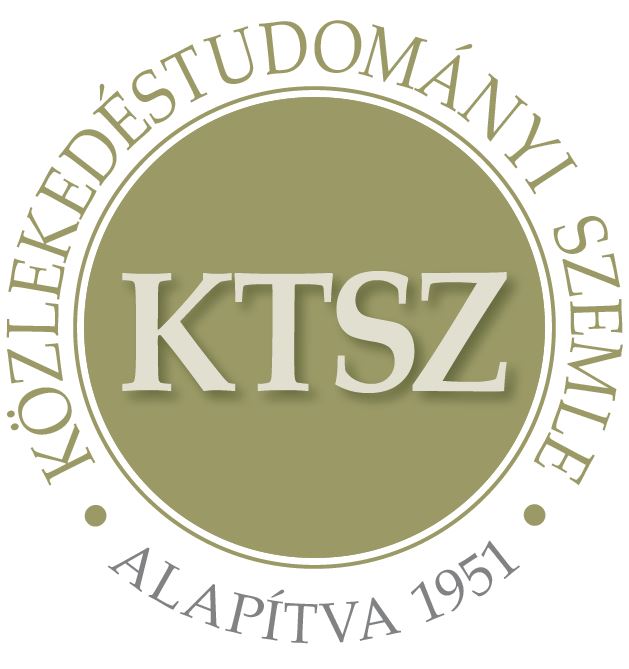Gyroscope compensated accelerometer sensor vehicle trajectory measurement
Abstract
The presentation of an improved method of accelerometer based distance measurement for the production of vehicle trajectories indicates that in reality, due to the road layout and surface defects, the inclination angle of the instrument changes continuously, which affects the final result of the measurement. It can be assessed what method can be used to solve this problem, and we get an idea of the accuracy and reliability of the measurement method through the analysis of the data measured during field experiments. The significance of the measurement method is that it can be used to measure distances with an acceleration sensor in any road conditions.
References
Mika P., „Járműtrajektória előállítása gyorsulás szenzorból nyert adatokból”, Közlekedéstudományi Szle., köt. 69, sz. 5, o. 18–28, 2019, DOI: http://doi.org/d2mp
Koller Sándor, Forgalomtechnika. Budapest: Tamkönyvkiadó, 1976.
Markó Gergely, Primusz Péter, és Péterfalvi József, Hajlékony útburkolatok élettartamának meghatározása a továbbfejlesztett kézi behajlásmérés alkalmazásával, köt. Kari Tudományos Konferencia Kiadvány. Nyugat-magyarországi Egyetem Kiadó, 2011.
R.R.Bartelsmeyer, C.D. Curtiss, és Wilbur S. Smith, „The AASHO Road Test”, Highw. Res. Board, sz. Report 6, 1962.
Fi István, „Háromrétegű rendszerek gépi úton való lehajlásszámítása útpályaszerkezetek méretezéséhez”, Mélyépítéstudományi szemle, köt. XXIV. évf., sz. 1, o. 33–36, 1974.
Gáspár László, Horváth Ferenc, és Lublóy László, Közlekedési létesítmények élettartama. Győr: Universitas-Győr Nonprofit Kft., 2011.
Kézdi Árpád, Talajmechanika II. Budapest: Tankönyvkiadó, 1954.
Nemesdy Ervin, „Útpályaszerkezetek méretezésének és anyagállandó-vizsgálatainak mechanikai alapja”, Budapest, 1985.
József T. és Gábor M., „Az útburkolatok állapotának felmérése új vizsgálati módszerek segítségével”, o. 23, 2017.
Vásárhelyi Boldizsár, Útépítéstan. Budapest: Tankönyvkiadó, 1951.
Kiss Béla és Krebsz Anna, „Valószínűségszámítás és matematikai statisztika”. 2006.
Havancsák Károly, Mérési adatok kezelése és értékelése. Typotex, 2012.
Articles published electronically are open access (OJS), freely available online and can be downloaded. Authors of articles are not charged any publication or publishing costs (APC). Users have the right to read, download, copy, print, and search the articles, or share the full text with a link.
Authors must declare that their submission has not been previously published in another journal, that financial support has been acknowledged, and that the list of references is complete and accurate, including specification of URLs and DOIs (if available). When submitting a draft article, each author approves the submitted version. Authors guarantee that the article is their original work. Authors are required to participate in the peer review process, follow the advice of reviewers, meet the prescribed deadlines, and, if any, withdraw the submission or correct errors.
All submitted articles are subject to peer review, where the editors request an independent evaluation from at least one expert, ensuring that the reviewer(s) have no conflicts of interest with the authors. The final decision is made by the Editor-in-Chief, who takes into account the evaluations and the suggestions of the editors. The editors and reviewers treat the submission confidentially.
The publisher and editors are committed to maintaining high ethical standards and to preventing publications that involve research misconduct. They follow the COPE guidelines on such ethical issues.
The authors retain copyright and grant the journal the right of first publication under the Creative Commons License (https://creativecommons.org/licenses/by-nc-nd/4.0), which allows others to share the work, while acknowledging the authorship of the work and the first publication in the journal.
The journal archives all published articles, and the journal's owner, the Hungarian Society of Transportation Sciences, will continue to operate the database even if the journal ceases to be published.















